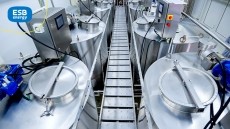Food and drink firms plug water use by 24%

Food and Drink Federation (FDF) figures reveal its members cut their use of water in the production of food and drink by 24.2% between 2007 and 2014. The savings represent 5.1M m3 of water – enough to fill more than 2,000 Olympic-size swimming pools.
FDF members’ water intensity use – or the amount of water needed per unit of production – fell by 26.3%, down by 0.69m3/t of product compared with 2007.
FDF director general Ian Wright said: “Increasing concern over future water supply means that water resources need to be used as sustainably as possible. Food and drink manufacturers have long recognised this and have been playing their part in improving water efficiency.”
Water saving initiatives
Water use reduction was at the heart of the FDF’s environmental ambition, he added. The result demonstrated the implementation of water saving initiatives across their manufacturing sites.
“We hope that this example will encourage many more companies to take action on water use and see the benefits for themselves.”
The reductions contribute towards industry’s Food and Drink Manufacturing Water Use Reporting – previously known as the Federation House Commitment – which revealed industry had cut its total water use by 15% since 2007, according to the FDF.
Over the past year, FDF members were said to have achieved a 3.6% reduction in water use.
Environment secretary Liz Truss said: “It shows this country has a food and drink industry that is leading the way in using innovation and technology to improve how it works, which underlines why they are one of the most exciting parts of our economy.”
Save millions of pounds
Meanwhile, food and drink manufacturers operating in England could save millions of pounds after the deregulation of water on April 1 2017, according to a seminar in London organised by law firm DWF.
Scottish water savings
- Over £35M in efficiency savings
- 26% increase in consumer satisfaction since deregulation, he said.
- £30M in discounts
- Helped customers save 16bn litres of water
Source: Business Stream
DWF director technical, commercial and intellectual property Sean Caldwell said producers in Scotland had seen significant benefits since its water industry had been deregulated during 2008.
In the past five years since deregulation, the main supplier Businesses Stream – formerly Scottish Water – had helped its clients achieve more than £35M in efficiency savings, while registering a 26% increase in consumer satisfaction since deregulation, he said.
It was also said to have made available £30M in discounts and helped its customers save 16bn litres of water.
Overall, deregulation was estimated to have saved water customers north of the border save billions of litres of water with an overall cost saving of £100M.
There were 28,000 large-scale manufacturing water users in England and from spring 2017 each could pick its own water supplier.
“There are likely to be four benefits of water deregulation in England: the ability to agree one deal [rather than many deals with a patchwork of suppliers], less management time required, greater purchasing power leading to less cost and greater supplier responsiveness and satisfaction,” said Caldwell.
Water deregulation: savings on tap
- Ability to agree one deal, rather than many deals with a patchwork of suppliers
- Less management time
- Greater purchasing power leading to less cost
- Greater supplier responsiveness and satisfaction
Sean Caldwell, DWF




















